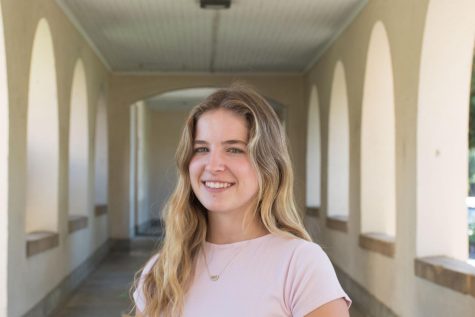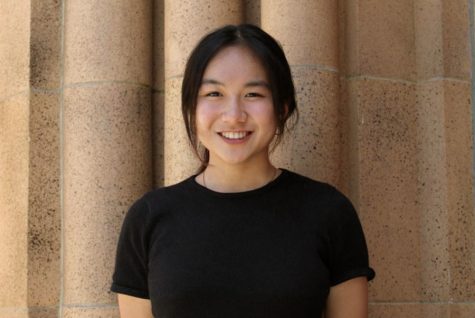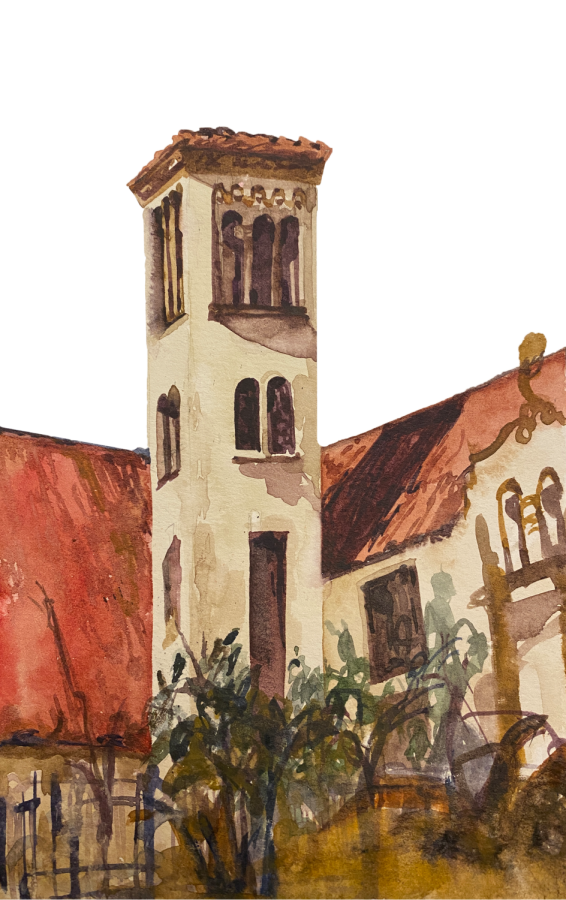Back to Campus
Explore all the ways that students, staff and others feel about going back
As of March 9, Palo Alto High School has allowed students to return to campus twice a week. Justified concern struck a portion of the community worried about safety precautions such as teachers being sent in person without vaccinations. Nonetheless, a significant group of the community also advocated the opposite—a reopening was necessary to combat the increasing social, emotional and academic isolation of students. After just over a year of living through a pandemic, varying experiences provide unique opinions on going back.
Principal Brent Kline never got to experience Paly culture before schools shut down last spring because he was hired on the cusp of all the chaos. After looking out onto an empty quad for months, Kline said it’s been fun to see some students fill the space.
“It’s like the clouds finally parted and the sun shone on our campus with the return of kids,” Kline said. “Although it wasn’t a huge amount, I saw a needle’s eye of what Paly’s about and what it’s like.”
And as far as reopenings go, few things were more highly anticipated than the return of athletics. Nelson Gifford, athletic director and administrator during hybrid learning, also shared his excitement for the full return.
“I understand the very real safety concerns that come with reintroducing people back into a close contact environment,” Gifford said. “However, I’m really impressed with the discipline and consideration that students have demonstrated with following the protocols while they’re on campus.”
According to Kline, one of his and other planning members’ main objectives was to help students with the challenges of remote learning. One of these students was freshman Miya Joshi, who set foot on campus for the first time this past March.
“It [online learning] actually had a really big effect on my mental health,” Joshi said. “It was hard for me to sit in front of a screen for seven hours and not be able to leave my house to see my friends. It’s hard for me to just learn on my own.”
Others voiced their discontent regarding the lack of teachers involved in the decisionmaking process. Science teacher Michael Mishali is recovering from leg surgery, meaning he’s not mobile enough to teach in person yet. Mishali is considering coming back after Spring Break because he wants to see students again, but thought the original timeline felt rushed.
“In the course of the school week, I am least happy on Mondays when I do Zoom-free lessons because I really do miss being in a classroom with kids,” Mishali said. “But I wish that we waited a little longer until more teachers were safely vaccinated until we return.”
Junior and ASB Site Council Representative Nysa Bhat agreed.
“Parents were consulted on this decision and sort of the board members and students, but I felt with the teachers, there was not that much representation for them and their voices were not being heard,” Bhat said.
Kline said that those involved in planning the reopening included several teacher leaders, counselors, his administrative team and more. Still, many teachers have chosen to continue instruction from home.
But the consensus isn’t black and white—some community members are left stuck in the middle, unsure of whether or not to go back at this point. Senior and School Board Representative Medha Alta was in the middle of the action making decisions alongside the school board, yet was still apprehensive when the first reopening plan was surveyed.
“When we got that survey to fill out for the previous reopening schedule I had said ‘no,’” Atla said. “I was going to stay home and committed to that.” The survey sent out in December had been the topic of much criticism at the time because of the limited flexibility in the options to return. However, Atla changed her mind soon after.
“By late January, I was like, ‘I can’t do this anymore,’” Atla said. “You hit your breaking point at different stages and for me I think late January was it.”
Anywhere on this spectrum of comfortability is a valid opinion, so it’s critical that we highlight them all. Mental health specialist Elizabeth Spector, who works in the Wellness Center, echoed this sentiment.
“It’s important to weigh all of the factors,” Spector said. “It’s not one-size-fits-all, so it’s important to know what it is that you and your family need and use that to guide you.”

Audrey Guo, Sophomore
The first day not a class went by without, “Audrey, are you in Paly?”
I was. After months in distance learning, an email in mid-January had assigned me to the Student Center to participate in a new “hybrid” learning program. This was before schools would open to everyone in March, before Palo Alto entered the orange tier and students started to feel optimistic. And despite thinking my days would be better spent in the comfort of my home than all of the Student Center’s discomforts, I decided to give it a shot. Worst case scenario, it’d make a pretty good story for later.
“What’s it like?”
My classmates and teachers would unmute one after the other, asking the same question. Encased in a plastic shield, I gave a rehearsed response: “Hybrid is good, but it’s surreal.” When each inquired further, I would then explain the oddity of having a virtual class watch you from the front and then another very real class watch from the back, left and right. This wasn’t the strangest part though.
Paly is located at the heart of Silicon Valley. Its campus is so enviable that, while calling their parents or making lunch plans with friends, us students will often say things like “pick me up at the bell tower” or “let’s meet near the arches” with an air of disturbing casualty. And yet, amidst Spanish-inspired architecture and the historic Haymarket, located at the heart of Paly is the ugly duckling of all buildings. The Student Center was where I’d be spending my next few weeks.
I stood in the Center’s doorway and walked clockwise, hitting something new with every two steps: desktop computers, taped-off water fountains, an ominous microwave, vending machines gathering dust and finally a small landfill of foldable tables. “Multipurpose room” doesn’t even begin to describe the amalgamation of things that the Student Center is; in fact, “multimultipurpose room” would be a better word.
As I seated myself by six or seven other kids behind shields, it seemed like the Center had been repurposed again.
But stranger than the classroom was the food. After two periods passed, our classroom supervisor pointed us at a cafeteria table heaped with plastic bags and tin boxes.
Others worried about the safety of returning. I worried about the safety of those lunches.
When I opened the tin container, several things happened very quickly. First I spotted a red package labelled “MINI French Toast: cinnamon rush” and on it, the Pillsbury Doughboy greeted me with a big smile—the first I had seen all day. For the most part I smiled back, until I realized he wasn’t pointing at the advertised french toast, but instead several toast-shaped bread-cake slices that had undergone a phase change and melted together.
I moved on quickly to a “Cocoa Puffs™ Cereal Bar,” carton of milk and complete absence of vegetables from the table. As I ate, I reminded myself that the lunch was free.
From my first days on campus to the last, my weeks in hybrid flew by quickly. I started packing my own lunch, taking walks around the quad and even enjoyed a donut from our classroom supervisor. But the best part was that I bonded with my classmates sitting six feet apart. Hybrid felt like our secret, a chance to sneak off to school and take the whole campus to ourselves.
Now in April, I see people grumble about the pointlessness of returning to school, how it all feels the same, distanced or not. But honestly? Going back to school for real, attempting “Zoom in a Room,” it’s been too close to real school. This isn’t like hybrid. Because it seems that somewhere along the way, I forgot the unattractive parts of a regular school day—how exhausting it can be and the inability to jump into the shower between classes and into bed immediately after. In the past year I’ve run my first (and second) half marathon, picked up coding skills, taken on risks and challenges; I’ve learned to spend time with my family and with myself. And I’ve lived with more freedom than I’ll be getting in years.
So maybe I’m not ready to return to normalcy yet. Maybe I’ll stay remote a while longer.

Noah Boyarsky, Sophomore
“I got an email telling me that I was going to be participating in hybrid learning, and I just kind of figured out where to go and what to do. It [hybrid learning] was just such a whirlwind of excitement, because I had been doing so poorly trying to figure out distance learning and the slog of being in the same room.
I’ve dealt with mental health issues in the past, and the thing about that is that even in normal times when there’s no COVID, it’s so hard to get out of bed every day and it’s so hard to be around other people. Even though [seeing my friends] was super hard to do, those things were how I stayed happy and healthy. And then all of a sudden it became so easy to just lay in bed all day and just be totally miserable.
Talk to the people you know who are already going back to school and see what it’s like. And then, unless you’re really convinced that you wouldn’t want to, I would recommend going just for a day. It might have an impact that you wouldn’t expect otherwise.”

Isa Morabia, Junior
“I’ve grown so used to being at home, it’s out of my comfort zone to go backto school and be somewhere else for a whole day, learning. I mean, it could be a good thing for my mental health and I don’t really know—we’ll see. Right now, I’m looking at it as a negative thing because I won’t be at home and in my own little bubble.”
Owen Rice, Junior
“After things shut down last spring, I started to realize my value for things in in-person school, like biking every morning to school. Sometimes it was a little harder if I was more tired. Sometimes it’d be less enjoyable. But just starting my day by getting out of the house [at] a good, consistent time, getting myself to school and being outside really helped me mentally get set. Even at the end of the day, biking home after school outside is always a calming, nice thing for me. It’s the start of my day and it’s the sigh of relief like, ‘Okay, I’m done with my day.’ Just being at school, walking around like I once was in between classes … it’s nice to mix it up.”

Emma Jacobi, Senior
Five days a week, senior Emma Jacobi can be found out on the slopes skiing. Before, she would only ski on the weekends—driving up to Lake Tahoe on Fridays and coming back down on Sundays—but distance learning has given her the chance to join a more rigorous team and practice on school days as well.
“I decided to, obviously, not go back to school because I wouldn’t be able to go skiing in the mornings,” Jacobi said.
Jacobi also had doubts about school safety and didn’t want to expose her parents to COVID-19. Even so, she empathizes with students who feel a lack of socialization since quarantine began.
“Since I’m a senior, you’re missing out on all these opportunities that you would normally have, which just overall sucks,” Jacobi said. “Maybe after the season’s over. I would definitely love to go back and see some of my friends but it’s not really a priority of mine right now.”

Michael Mishali, Teacher
“I feel the absence of students in my life and I do think I will feel better when I’m back on campus seeing kids safely.
But I don’t think it’s okay to destroy the safety of schools. Students and teachers should feel safe at school, and the rush back, less than a month before teachers would have been vaccinated, does not feel good to me.”

Stacey Kofman, Teacher
“One of the reasons I stay at school because I didn’t want to bring [my models] home. I have two skeletons. One is very fragile and breaking and then I have all sorts of little joint models that I don’t want to break.”
Nelson Gifford, Athletic Director
“During hybrid it was so weird to be in a room full of teenagers and there being no sound, and so I’m ready for there to be sound again.
Before the pandemic, you go into Starbucks. What did you see? You saw people on their laptop, working. Why weren’t they at home? Is the internet there that much better? They can make coffee at home. Why do they need to go to Starbucks?
It’s the same thing. You know you’re around people doing the same thing, that are giving you energy simply from their presence. So, being at school, you can get some of that energy to know that, in fact, what you’re experiencing is not isolated that we’re all going through this process together. And it’s just that sense of community.”

Sima Thomas, Librarian
“It feels different to get up and shower and put on an outfit and come and be around other people. Even though my job hasn’t changed, I even feel mentally more engaged in what I’m doing.
I didn’t ever really feel like I could totally do my job off campus. Classroom teachers are able to log on to Zoom and their classroom is where they are and even if it’s on Zoom, they are a classroom. Because I have more physical materials that I work with, I felt like I needed to be here. I wanted to make sure students were still getting access to print books.”

Brent Kline, Principal
“It’s been a long, long last few months,” Kline said. “And it’s been a very, very short, fun last [few] weeks.”
Tuesdays through Fridays, principal Brent Kline can be found on the quad checking in with students. As someone deeply involved in planning the return, Kline said the purpose of opening Paly doors was to let kids get out of the house and interact with their peers and teachers.
Still, many community members didn’t see it that way. Both the current and initial January plans to return were met with heavy criticism.
“I try not to take it personally,” Kline said. “It’s easier said than done. I think it’s easy to criticize something that, as an individual person, you need and you’re not receiving.”
Kline wanted people to know that making these decisions involves more than just himself. It’s a conversation between administrators, teacher leaders, counselors and others.
“Everybody’s had a piece of the puzzle in terms of creating what we created,” Kline said. “Just as any principal, you need to know the whole picture and every single piece that makes up that whole.”
And despite claims of little teacher representation, those involved in the planning said they wanted to accommodate as many people as possible. To do so, Kline had to sideline some of his own aspirations.
“I wish that we could create a school where everybody could return safely and fully, but we can’t right now. I wish that we could open faster. I wish that we could have more kids on campus,” Kline said. “When it’s all said and done, [the current plan] is the right way to go because I want to ensure that our teachers, our adults and our students are entering a safe environment with explicit expectations and that we’re all following them.”
• Art by Audrey Guo

2020-2021 - Staff Writer
2021-2022 - Managing Editor
I joined C mag because I have always been interested in art and design and wanted to pick that...

2020-2021 - Staff Writer
2021-2022 - Digital Design Editor
2022-2023 - Creative Advisor
I joined C-Mag because of our amazing page designs and...







